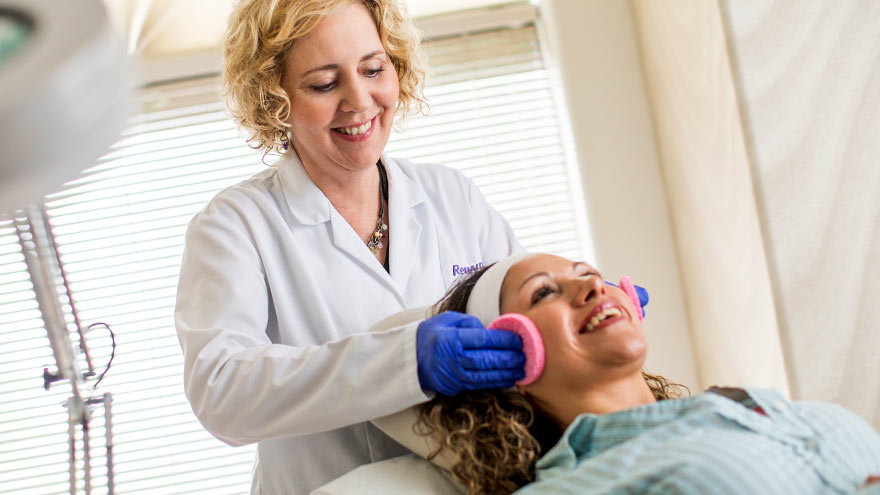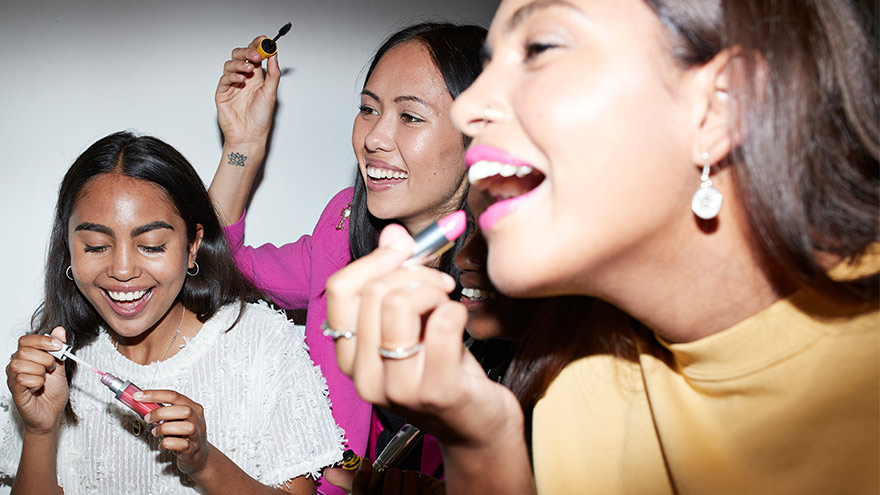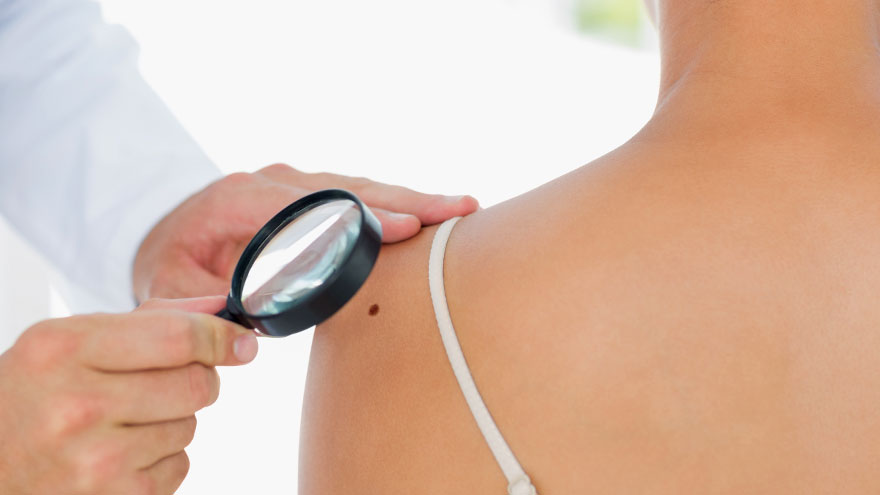Search
Results for 'urgent care'
Clear-
Skin Care Specials
Seasonal Specials to Help You Stay on Point Revamp your glow without breaking the bank at Renown Health Dermatology! Explore our array of skin care products and services designed to make you look and feel sensational. Swing by our South Reno office to check out our latest product lines. Our skincare experts are on hand to help you navigate your beauty routine and answer all your questions. Why not indulge yourself or surprise a friend? Gift certificates are ready and waiting—perfect for any occasion!
-
Winter Skin Care: 5 Must-Know Pro Tips
As the seasons shift, so do the demands of our skin. We sat down with Heidi Nicol, a seasoned aesthetician at Renown Dermatology, Laser & Skin Care, to uncover the secrets of pampering your skin during the winter onset. The aftermath of summer often leaves us with dry, dull skin and unexpected breakouts. However, a few tweaks to your skincare regimen can make this seasonal transition smoother. 1. Re-evaluate Your Cleanser Now might be the opportune moment to transition to a non-drying cleanser. The one that worked wonders in the summer might be aggressive for the colder months. Nicol suggests opting for a "gentle" cleanser that effectively cleanses and exfoliates without including abrasive ingredients. 2. Amp Up the Hydration With the dip in temperature, your skin craves a richer moisturizer. Seek out products enriched with Hyaluronic Acid. This powerhouse ingredient amplifies your skin's ability to retain moisture, ensuring it stays supple throughout the day. 3. Introduce Retinol If retinol isn't a staple in your skincare arsenal yet, consider introducing it now. Its prowess in diminishing sun-induced brown spots and fine lines is unparalleled.
-
7 Morning Skin Care Tips for All-Day Protection
We talked to Heidi Nicol, licensed aesthetician with Renown Dermatology, Laser and Skin Care, to learn about the 7 best morning skincare tips that will provide all-day protection. “Your skin uses the nighttime hours to repair itself, secreting oils and toxins in the process,” says Heidi Nicol, a licensed aesthetician with Renown Dermatology, Laser and Skin Care. “Cleansing your skin in the morning is very important. It removes these oils and toxins and any nighttime products you use that are not suitable for daytime use — such as retinol and exfoliating acids.” Nicol’s process includes choosing the right products for your skin type, using them in the proper order and applying them correctly. Steps to Perfect Your Morning Routine Step 1: Cleanser. Use a cleanser tailored to your skin type. Many lines of products produce unique formulas for your specific skin, including dry skin, oily skin, and a combination of the two. Be sure to rinse, rinse, and rinse again! Step 2: Toner. After cleansing, you should apply a toner quickly. This is like a big drink of water for the skin and helps trap moisture into your skin and prevent evaporation. Step 3: Serum. Choose a serum that addresses your skin’s needs. If you use more than one type of serum, alternate them instead of layering. Nicol recommends using a Vitamin C serum, an antioxidant serum, and hydrating serums. Step 4: Moisturizer. Select a daily moisturizer that fits your skin type. Step 5: Eye Cream. “A good eye cream is refreshing and can help the delicate skin around the eyes,” says Nicol. Step 6: Sunscreen. This is the most essential step when it comes to protecting your face. Some sunscreens come tinted, which can replace foundation. “Do not forget to also apply to the neck, chest, and hands,” says Nicol. “It is important to reapply every few hours when you are out in the sun.” Step 7: Makeup. After you’ve completed the above steps, proceed with your make- up routine. This is a crucial step for protecting your skin. Many aestheticians recommend wearing makeup every day.
Read More About 7 Morning Skin Care Tips for All-Day Protection
-
11 Easy Ways to Prep Your Skin for Spring
As we begin to enjoy the springtime weather in northern Nevada, are you finding your skin less than tip-top shape? Here’s how to add moisture back in easy, natural ways. You don’t need to be a medical aesthetician: Dry, cold climates can often wreak havoc on your body’s largest organ — your skin. These tips from Renown Dermatology, Laser & Skin Care will quickly put moisture back and relieve dry, chapped skin. 11 Miraculous Moisturizing Tips Always wear broad-spectrum sunscreen, even during winter months. Don’t forget to use an SPF lip balm, too. Heaters dry out your skin. Use a humidifier to keep moisture in the air. (And try these simple tips to make sure you’re keeping that humidifier clean.) If your skin is dehydrated, try using a nighttime moisturizer during the day. Use a hydrating mask or moisturizing mask twice a week. Don’t forget your hands and feet. Apply a rich cream to the hands and feet at night and cover them with gloves and socks to restore moisture while you sleep. Drink plenty of water to stay hydrated. Try adding a hydrating serum to your morning and nighttime skincare routine to heal the skin. Use a gentle exfoliant to remove dry skin at least once a week, which helps your skin absorb your moisturizer. Apply body oil or lotion in the shower while your skin is still damp to trap moisture. Hot water dries out your skin, so turn down the temperature in the shower and bath. A little pampering goes a long way, and Renown’s medical aestheticians are here to help. Trained in skincare and advanced therapies, our experts can transition your skin to look healthy, youthful and rejuvenated.
-
Winterize Your Skin with These 5 Easy Expert Tips
Winter skin alert – cold temperatures can put your skin into chaos. We asked for skin tips from Heidi Nicol, an esthetician with Renown Dermatology, Laser & Skin Care. She shares how to keep your skin glowing through the frosty months ahead. With the change from warm to cold weather, your skin can get stressed out. In fact, issues like flaky skin, irritation and chapped lips can be an everyday struggle. 5 Easy Winter Skincare Tips 1. Re-think your shower Few things feel better on a cold day than a long, hot shower. But hot showers can lead to dry skin because they strip your skin of its natural protective oils. Avoiding them altogether is best – choose a lukewarm, or warm, shower instead. If you have an occasional hot shower, the American Academy of Dermatology (AAD) suggests keeping it at five to ten minutes. Nicol recommends using a gentle cleanser and avoid using too much. Moisturizing after a shower or bath while your skin is still damp is also a must. Slathering on your favorite lotion helps your skin hold on to precious moisture. 2. Stay away from smoke and fire Although sitting close to a roaring fireplace can feel good, it is drying to your skin. Smoking and exposure to smoke also harms your skin. Smoking reduces healthy blood flow to the skin. This also causes your skin to wrinkle faster, making you looker older. Additionally your skin heals much slower if you smoke. 3. Consider a humidifier Cranking up the thermostat dries out indoor air. Skin is our largest organ, and in general, heat is very drying to your skin. To clarify, over time dry air degrades your skin’s natural moisture (lipid) barrier leading to flaking, peeling and cracking. Your skin can overcompensate for the dryness by producing even more oil. In other words it is possible for your skin to be both oily and dehydrated at the same time. Even oily skin needs a daily lightweight, non-pore clogging moisturizer. 4. Use SPF daily The sun’s rays damage your skin even on cloudy days. Sunlight contains UVB (burning) and UVA (aging) rays. Although UVB rays are less strong in the winter, the UVA rays are same strength all year. And snow can reflect almost 90% of UV radiation. With this in mind make sure you have suitable skin and eye protection when going outdoors. 5. Take care of your hands and feet Don’t forget your fingers and toes when moisturizing. These areas tend to be drier than other parts of the body. Gloves help to protect hands from winter weather and lock in moisture. Similarly, putting lotion on your feet before your socks will keep them your skin from flaking and cracking. Follow the tips above to make sure your skin is at its best, despite the winter weather. Renown Dermatology, Laser & Skin Care | 775-982-8255 Renown Dermatology, Laser & Skin Care offers a comprehensive range of treatments and products to address any skin care need. Visit our beautiful office in south Reno and browse our product lines. Experts are available to answer any questions concerning your skin care and health and wellness needs.
Read More About Winterize Your Skin with These 5 Easy Expert Tips
-
Top 3 Dermatology Services
Our skin loses its elasticity and ability to retain moisture as we age. As a result, sun exposure leads to age spots, wrinkles and even cancer. Dermatologist-recommended treatments can reverse the signs of aging and help resolve skin conditions. The board-certified experts at Renown Dermatology, Laser and Skin Care provide care for various skin conditions—from psoriasis and acne to skin cancer. We've outlined the top three treatments available, how they work, and the results you can expect. 1. Define with Dermaplane Our popular Dermaplane procedure exfoliates the outermost layer of dead skin cells, and vellus hairs (peach fuzz), leaving the skin smooth and supple. A glycolic peel is then added for a fresh, healthy glow. Dermaplane can be combined with other skin care treatments and will reveal immediate results with zero downtime! Your vellus (fine) facial hair will not become thicker or darker after dermaplaning. Instead, the hair will grow back but won't change color or thickness. 2. Illuminating Omnilux LED Light Therapy LED therapy is a natural treatment, does not contain harmful UV wavelengths, and does not create heat or thermally damage the skin. Omnilux LEDs emit light photons of specific wavelengths into your skin and are absorbed by cell components, particularly the mitochondria. Two Types of Light Therapy Red Light Reduces wrinkles by stimulating elastin and collagen Improves skin tone Warm, relaxing 20-minute treatment with no downtime Blue Light Reduces active acne Helps reduce redness and inflammation Reduces length of breakouts Relaxing 20-minute treatment with no downtime 3. Therapeutic Triple Facial Plus Reduce the appearance of fine lines instantly with our most popular skincare package. This ultra-conditioning treatment freshens the skin's appearance without extended healing or downtime. Enjoy three treatments in a single 60-minute session: Dermaplaning for exfoliation and the removal of vellus hair Glycolic mask for a fresh, healthy glow Laser toning for collagen stimulation The Dermatology, Laser and Skin Care team offers competitively-priced treatments and procedures. In addition, our seasonal specials provide competitive pricing to help you stay on budget. Sign up and be the first to know about money-saving cosmetic service specials sent to you quarterly!
-
Prevent Breakouts by Keeping Your Makeup Tools Clean
Did you know that your makeup brushes are likely full of built-up dirt and bacteria? Using dirty makeup tools can lead to irritation, breakouts and even infections. The good news? It's completely preventable. An expert explains For anyone who regularly wears makeup, brushes are great tools for powdering, contouring and finishing touches. Unfortunately, these same brushes also harbor harmful bacteria that can clog pores and cause unwanted breakouts. “Brush hairs and sponges are porous, and hold on to oils, debris and bacteria,” says Heidi Nicole, medical esthetician with Renown Dermatology, Laser & Skin Care. “Also, if they are dirty, the application of makeup can be spotty and make blending more difficult." Most dermatologists suggest that you clean your makeup brushes at least once a week. Because they are used on your face, it makes sense to keep them as a clean as possible. In addition, your brushes will last longer if you stay on top of cleaning them. Six simple steps to integrate makeup brush care into your beauty routine: Wet your brush with lukewarm water. (Don’t soak your brushes, as water in the brush barrel can cause the hairs to fall out.) Place a drop of gentle cleanser or specialized brush cleaner in the palm of your hand. Gently massage the tips of the bristles on your palm. Rinse the bristles well. Blot with a clean towel and reshape the head. Let the bristles dry over the edge of a counter. Do not allow the bristles to dry on the towel, which could cause the brush to mildew. Store your brushes in a clean, dry place in between uses.
Read More About Prevent Breakouts by Keeping Your Makeup Tools Clean
-
Fall Skincare and Sunscreen Tips
According to the Skin Cancer Foundation, higher altitude increases the risk of sun-induced skin damage. UV radiation exposure rises 4 to 5 percent every 1,000 feet above sea level. In addition, snow reflects up to 80 percent of the UV light from the sun, meaning that you are often hit by the same rays twice. This only increases the risk of damage. If you're among the 58 percent of adult Americans who choose not to wear sunscreen, you may be even less likely to apply sunscreen during the fall and winter. Experts at the William N. Pennington Cancer Institute, explain that exposure to the sun happens when we least expect it, like during our daily commute. The ultraviolet A (UVA) rays can penetrate the windows of your car, office or home and get deep into the dermis, the thickest layer of our skin. So what’s the solution to preventing skin damage — or even worse, skin cancer — in the colder months? Apply, then Re-apply Sunscreen "There are a million sunscreens, so find one that feels good on your skin. Hydrating formulas are great for the drier months, so use a broad spectrum UVA and UVB lotion with a mix of ingredients to ensure you are fully protected." Still not sure which sunscreen to use? Look for the Skin Cancer Foundation Seal of Recommendation next time you’re out shopping for your sun protection products. A good rule of thumb is to use about one ounce (a shot glass full) and re-apply every two hours, or more often if sweating. Also, make sure to: Follow directions and shake the bottle before using. Make sure all skin is covered (including neck, ears and lips). For people with thin or thinning hair, apply to the scalp as well. Carry your favorite bottle of sunscreen with you at all times. Skiers, snowboarders, snowshoers, sledders, snow shovelers and winter enthusiasts take note: When spending time out the snow, we recommend a sport sunscreen with an SPF of at least 30.
-
Are You Using the Right Sunscreen?
Seeking protection for yourself and your loved ones from the intense sun rays at northern Nevada's elevated altitudes? With so many choices available, selecting the ideal sunscreen can be daunting. To guide you through this, we consulted Dr. Angela Walker, a dermatologist from Renown Medical Group, for her expert insights. Sunscreen Application Dermatologists recommend a broad-spectrum sunscreen with a minimum SPF of 30, but keep in mind that no sunscreen protects against 100 percent of UV radiation and that reapplication is necessary. “No matter the SPF, sunscreen must be applied adequately and frequently, meaning a quarter-sized amount to cover the face and neck and a full shot glass amount for the body when wearing a bathing suit,” said Walker. “Reapplication should be every 80 minutes.” Why not use a high SPF, such as 70 or 100? According to the Skin Cancer Foundation, they don’t offer significantly more protection than SPF 30 and mislead people into thinking they have a higher level of protection. Here’s the breakdown: SPF 15 blocks 93 percent of UVB rays SPF 30 blocks 97 percent of UVB rays SPF 50 blocks 98 percent of UVB rays SPF 100 blocks 99 percent of UVB rays Do specific populations require a higher SPF? Walker explains that infants, seniors, and those with a history of skin cancer must take precautions against UV radiation, as their skin is vulnerable. Sunscreen should be an absolute priority before spending time outdoors and avoiding prolonged sun exposure, wearing a hat with wide brim (recommended 4-inch brim) and UPF (ultraviolet protection factor) clothing. Due to the sensitive nature of an infant’s skin, babies under six months should not spend time in the direct sun. For infants and toddlers six months and older, whose skin is thinner than adults, a sunscreen that contains zinc oxide or titanium dioxide (physical protectors) should be applied. Zinc and titanium are less likely to irritate because they do not penetrate the skin and instead sit on the surface and deflect UV radiation. Zinc oxide and titanium dioxide are vital ingredients to seek out in sunscreen due to their strong ability to deflect UV radiation. Sunscreen Terms Explained UVA = Long wave ultraviolet light. Penetrates deep into the dermis, the skin’s thickest layer, causing tissue damage that wrinkles and photo-aging and contributes to developing skin cancer. UVB = Short wave ultraviolet light. The biggest contributor to the development of skin cancer and are more prevalent during mid-day. SPF = Sun protection factor. Calculated by comparing the amount of time needed to burn sunscreen-protected skin vs. unprotected skin. So, SPF 15 means you can stay in the sun 15 times longer than you could without protection.
-
Renown Dermatology
At Renown Dermatology, Laser & Skin Care, our experienced providers offer a wide range of services, coupled with advanced medical technology. Skincare services include dermatology and competitively-priced treatments and procedures. Our professional and compassionate staff focuses on promoting lifelong health and wellness in a relaxing, modern atmosphere.
-
Preventing Skin Cancer A Doctors Tips
Want to protect yourself from skin damage from the sun’s harmful rays? Dr. Angela Walker, dermatologist with Renown Medical Group, shares what you can do to prevent skin cancer. What can people do to prevent skin cancer while enjoying the outdoors? There are several steps you can take to protect your skin from the sun. “I caution all of my patients to avoid the sun during the hours of 10 a.m. until 2 p.m. when UV rays are strongest. I also encourage people to wear sleeves on cooler days. And don’t forget that we still need to wear sunscreen on cloudy days! UV rays can still cause sun damage on cloudy days. Preventing skin cancer also entails wearing sunscreen of at least SPF 30 everyday. Are hats also a good idea for skin protection? Yes, of course! Choose a wide-brim hat that shades the face as well as the back of the neck for extra protection against UV rays. When it comes to identifying skin cancer, what should people watch for? We use easy-to-remember letters when checking for spots on the skin; it’s called the ABCDEs: A - Asymmetry: One half of the mole or lesion doesn't match the other half. B - Border irregularity: The edges of the mole are irregular, blurred, or notched. C - Color variation: The mole has different shades of color or uneven color distribution. D - Diameter: The diameter of the mole is larger than the size of a pencil eraser (about 6 millimeters) or is increasing in size. E - Evolution: Any changes in the mole over time, such as size, shape, color, itching, bleeding, or crusting. These guidelines can help in identifying potentially suspicious skin lesions, but it's important to consult a dermatologist for proper evaluation and diagnosis. Early detection is crucial for successful treatment of skin cancer.
-
Learn to Spot Skin Cancer
With skin cancer affecting one in five Americans and 3.5 million new skin cancer cases diagnosed yearly, being proactive about prevention is vital to your health. Dr. Angela Walker, a dermatologist with Renown Dermatology, Laser and Skin Care, explains. The 5 stages of melanoma How should someone examine their skin for moles? I recommend practicing monthly head-to-toe self-examination of your skin, so you can find any new or changing moles or marks that might be cancerous or precancerous. Skin cancer is the most common of all cancers. It is also the easiest to cure if diagnosed and treated early. Therefore, self-examination can alert you to changes in your skin and aid in early skin cancer detection. Self-examination tips: Make sure you have a bright light, full-length mirror, hand mirror and a blow-dryer. Examine your face, especially your nose, lips, mouth and ears, both front and back. Thoroughly inspect your scalp, using a blow-dryer and mirror to expose each section. You might need to get a friend or family member to help. Check your hands carefully: palms and backs, between the fingers and under the fingernails. Continue up the wrists to examine your forearms' front and back. Standing in front of the full-length mirror, begin at the elbows and scan all sides of your upper arms. Don't forget the underarms. Next, focus on the neck, chest and torso. Women should lift their breasts to view the undersides. With your back to the full-length mirror, use the hand mirror to inspect the back of your neck, shoulders, upper back and any part of the back of your upper arms you didn't already check. Scan your lower back, buttocks and backs of both legs. Check the front and sides of both legs, thigh to shin, ankles, tops of feet, between toes and under toenails. Examine the soles of feet and heels.











